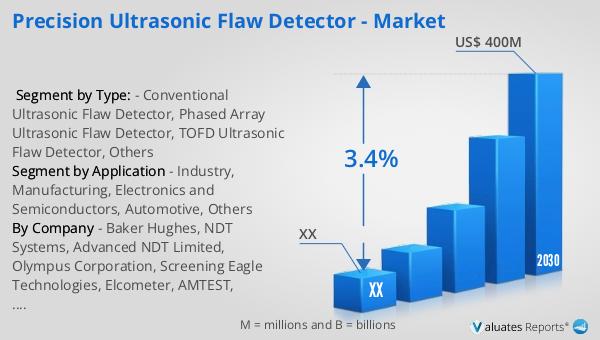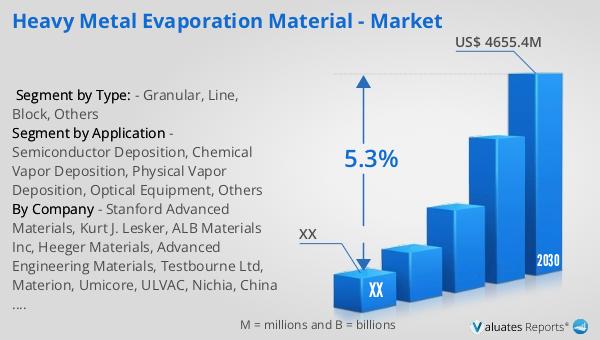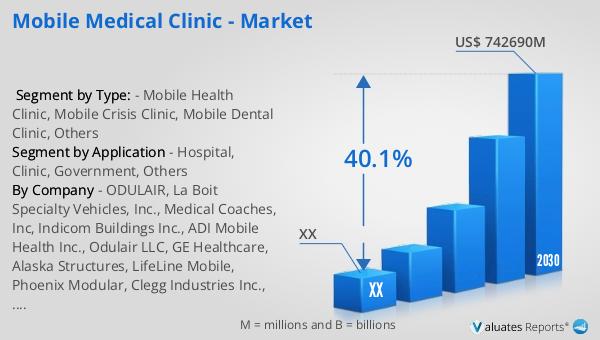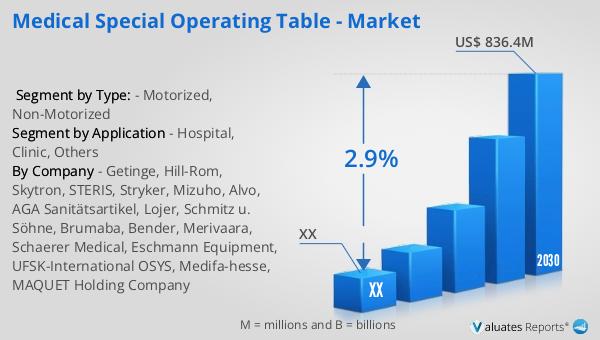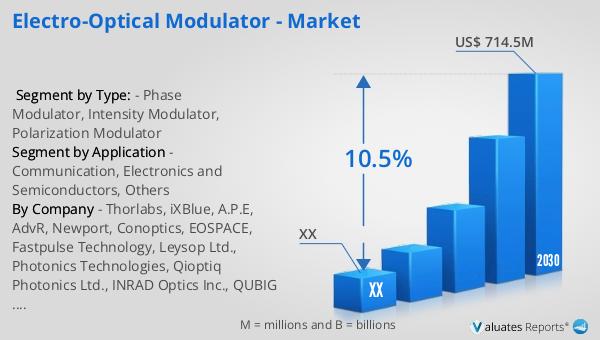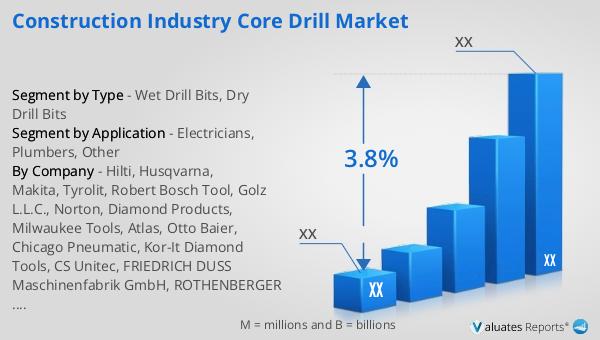What is Gold Evaporation Materials - Global Market?
Gold evaporation materials are a crucial component in various high-tech industries, primarily used in thin-film deposition processes. These materials are typically high-purity gold, which is vaporized in a vacuum chamber and then deposited onto a substrate to form a thin film. This process is essential in manufacturing semiconductors, solar cells, and other electronic devices. The global market for gold evaporation materials is driven by the increasing demand for advanced electronics and renewable energy solutions. As technology continues to evolve, the need for more efficient and reliable thin-film deposition techniques grows, further propelling the market. Additionally, the unique properties of gold, such as its excellent conductivity and resistance to oxidation, make it an ideal choice for these applications. The market is characterized by a high level of competition, with numerous players striving to develop innovative products and improve production processes to meet the growing demand. As industries continue to expand and innovate, the global market for gold evaporation materials is expected to experience significant growth, driven by technological advancements and the increasing adoption of renewable energy sources.
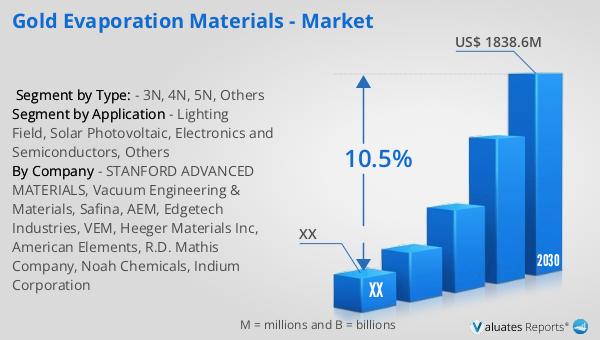
3N, 4N, 5N, Others in the Gold Evaporation Materials - Global Market:
Gold evaporation materials are categorized based on their purity levels, commonly referred to as 3N, 4N, 5N, and others. These designations indicate the number of nines in the purity percentage of the gold used. For instance, 3N gold has a purity of 99.9%, 4N gold is 99.99% pure, and 5N gold boasts a purity of 99.999%. Each level of purity serves different applications and industries, depending on the specific requirements of the end product. 3N gold evaporation materials are typically used in applications where ultra-high purity is not critical but where the excellent conductivity and corrosion resistance of gold are still required. This level of purity is often sufficient for decorative coatings and some electronic applications where cost considerations are more significant than the need for the highest purity. 4N gold, with its higher purity, is more commonly used in the electronics and semiconductor industries, where even minor impurities can significantly affect the performance and reliability of the final product. The increased purity ensures better conductivity and fewer defects in the thin films, making it ideal for critical components in electronic devices. 5N gold evaporation materials represent the pinnacle of purity and are used in the most demanding applications, such as advanced semiconductor manufacturing and high-precision optical coatings. The near-perfect purity of 5N gold ensures the highest level of performance and reliability, which is crucial in these high-tech applications. Other purity levels, beyond 5N, are also available for specialized applications that require even greater precision and performance. These ultra-high purity materials are often used in research and development settings, where the slightest impurity could compromise the results of an experiment or the functionality of a prototype. The choice of purity level in gold evaporation materials is a critical decision that depends on the specific requirements of the application, balancing cost, performance, and reliability to achieve the desired outcome. As technology advances and the demand for high-performance materials grows, the market for gold evaporation materials across all purity levels is expected to expand, driven by the need for more efficient and reliable thin-film deposition processes.
Lighting Field, Solar Photovoltaic, Electronics and Semiconductors, Others in the Gold Evaporation Materials - Global Market:
Gold evaporation materials play a vital role in various industries, including lighting, solar photovoltaics, electronics, and semiconductors. In the lighting field, gold evaporation materials are used to create reflective coatings that enhance the efficiency and brightness of lighting devices. These coatings are applied to components such as reflectors and mirrors, improving the overall performance of lighting systems. The excellent conductivity and resistance to tarnishing of gold make it an ideal choice for these applications, ensuring long-lasting and reliable performance. In the solar photovoltaic industry, gold evaporation materials are used to create thin films that improve the efficiency of solar cells. These films enhance the electrical conductivity and light absorption properties of the cells, leading to higher energy conversion rates and more efficient solar panels. As the demand for renewable energy sources continues to grow, the use of gold evaporation materials in solar photovoltaics is expected to increase, driven by the need for more efficient and cost-effective solar solutions. In the electronics and semiconductor industries, gold evaporation materials are used to create thin films that form critical components of electronic devices. These films are used in the production of integrated circuits, sensors, and other electronic components, where the high conductivity and reliability of gold are essential. The use of gold evaporation materials in these industries is driven by the need for more advanced and reliable electronic devices, as well as the ongoing miniaturization of electronic components. Other applications of gold evaporation materials include the production of optical coatings, decorative coatings, and various research and development projects. In optical coatings, gold is used to create thin films that enhance the reflectivity and durability of optical components, such as lenses and mirrors. Decorative coatings benefit from the aesthetic appeal and durability of gold, making it a popular choice for high-end products and luxury items. In research and development, gold evaporation materials are used to create thin films for experimental purposes, where the high purity and reliability of gold are crucial for accurate results. As industries continue to innovate and expand, the use of gold evaporation materials in these and other applications is expected to grow, driven by the need for more efficient and reliable thin-film deposition processes.
Gold Evaporation Materials - Global Market Outlook:
The global market for gold evaporation materials was valued at approximately $9,021 million in 2023. It is projected to undergo a significant transformation, with an anticipated adjusted market size of around $1,838.6 million by 2030. This change reflects a compound annual growth rate (CAGR) of 10.5% during the forecast period from 2024 to 2030. The North American segment of this market was also valued at a substantial figure in 2023, with expectations of reaching a new valuation by 2030, maintaining a steady CAGR throughout the forecast period. This growth is indicative of the increasing demand for gold evaporation materials across various industries, driven by technological advancements and the rising adoption of renewable energy solutions. The market's expansion is fueled by the need for high-purity gold materials in applications such as electronics, semiconductors, and solar photovoltaics, where the unique properties of gold, including its excellent conductivity and resistance to oxidation, are highly valued. As industries continue to innovate and expand, the global market for gold evaporation materials is poised for significant growth, supported by the ongoing development of new technologies and the increasing demand for more efficient and reliable thin-film deposition processes.
| Report Metric | Details |
| Report Name | Gold Evaporation Materials - Market |
| Forecasted market size in 2030 | US$ 1838.6 million |
| CAGR | 10.5% |
| Forecasted years | 2024 - 2030 |
| Segment by Type: |
|
| Segment by Application |
|
| By Region |
|
| By Company | STANFORD ADVANCED MATERIALS, Vacuum Engineering & Materials, Safina, AEM, Edgetech Industries, VEM, Heeger Materials Inc, American Elements, R.D. Mathis Company, Noah Chemicals, Indium Corporation |
| Forecast units | USD million in value |
| Report coverage | Revenue and volume forecast, company share, competitive landscape, growth factors and trends |
